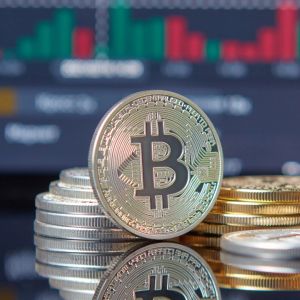What A U.S. Sovereign Debt Crisis Means For Bitcoin
10 min read
Summary I rate Bitcoin a Strong Buy, as macro conditions favor its potential to mature into a global reserve asset amid US debt and credibility crises. The US is likely to follow Japan and Italy in permanent monetary expansion, fueling currency debasement and boosting demand for scarce assets like Bitcoin. Bitcoin’s price rises with increased global liquidity, supported by its scarcity and durability. We now live in a world where all major economic blocs are set to increase liquidity. Bitcoin remains a high-risk, asymmetric bet, but I think the current global monetary expansion makes this an excellent entry point for long-term investors. Seven years ago, Vijay Boyapatii published an article titled “The Bullish Case for Bitcoin” on Medium. A non-technical introduction to Bitcoin USD ( BTC-USD ), the article became a hit in the Bitcoin community and was also published as a book later. I recommend anyone interested in understanding Bitcoin – skeptics included – to read it. The reason I like this piece is that it does an excellent job of explaining why Bitcoin has all the characteristics to be a superior global reserve asset. I have discussed most of these elements myself in my past coverage of Bitcoin: Arguing how Bitcoin may be stuck in a specific trading range long term. Discussing how Bitcoin has evolved to be a reserve asset , not a currency. Updating my bull case for the Trump administration . In this article, I won’t repeat myself, and I will take for granted that readers are aware of the technical characteristics of Bitcoin . I will focus this piece on discussing the probability of Bitcoin maturing as a global reserve asset in light of the current macro scenario. I believe recent events in the bond markets are sending a clear signal: there is a growing need for a superior, neutral global reserve asset to fight currency debasement. The US debt & credibility crisis: to understand it, look at Italy and Japan There is no denying that US debt has been undergoing a crisis since Trump took office. Yields on 10-year US bonds ( US10Y ) are rising, being close to all-time highs for the year. This is happening despite a Q2 US GDP contraction , cool CPI data at just above 2%, and Truflation (a proprietary, non-lagging inflation indicator) being under 2% for more than two months. Why is this happening? As I have outlined in previous pieces covering the iShares 20+ Year Treasury Bond ETF ( TLT ), I think this is a function of two dynamics: US Interest rates might stay higher for longer because of inflationary pressures coming from the uncertain scope of trade tariffs and a ballooning US deficit (and US debt). Uncertainty over the direction of interest rates is understandable, given the recent tax cuts bill that passed in Congress and the fact that the US is running a deficit in line. Some foreign actors may be selling US treasuries for political reasons (including Trump’s trade war), inducing a further decline in demand for US Debt. The results are visible, with a weak auction for 20 and 30-year treasuries that took place on May 21. I see the current US Debt crisis as a credibility issue. Despite running on a political platform that heavily criticized Biden’s approach to a large government deficit in times of full employment, I believe markets are waking up to the fact that America’s deficit (and ballooning debt) are never going to be tackled. All the while, demand for US debt is decreasing as Trump alienates trade partners that used to be major buyers of US debt. To understand what the future may look like for US debt, I find it helpful to look at areas of the developed world that have already undergone a debt crisis. First, let’s take Italy . The country has struggled with ballooning debt and one of the world’s highest GDP-to-debt ratios since the early 2010s. What readers may be surprised to hear is that Italy has de facto bankrupted in the open market during the pandemic. Italy debt, ECB purchases (OMFIF dot org) The chart above shows how for a few quarters during the peak of the pandemic, the European Central Bank (ECB, marked as “Banca d’Italia” in the chart) was the only net buyer of Italian debt. In other words, the only reason why Italy was able to finance its debt for the best part of one year is because the ECB acted as a lender of last resort . The second, and perhaps more known case, is about Japan . Japan’s GDP to public debt ratio is the highest in the world for a developed nation. The country is de facto relying on issuing debt to face a secular declining demographic trend that is only compounded by stagnant productivity . Once again, the reason Japan’s economy has been somewhat resilient despite its skyrocketing debt is because the Bank of Japan [BoJ] has acted as a lender of last resort. JGBs held by the BoJ (nippon dot org) The chart above shows exactly how the BoJ has held an increasing amount of debt issued by the government of Japan, to the point that this now represents more than half the total holdings in the BoJ’s balance sheet. How is a US sovereign debt crisis going to impact Bitcoin? We are at a point where the US is to de facto leave its debt uncontrolled and run a permanent deficit regardless of the status of the economy. In other terms, the “supply” of US debt (issuance of new bonds) is set to increase in the long run. At the same time, we are also witnessing a decrease in global demand for the same debt – thanks, at least in part, to Trump’s own trade policies, which alienate countries that historically bought most of America’s debt, such as Japan and China. In the context of an increase in new debt and a decrease in demand, I believe it’s reasonable to assume that the US will have to resort to “buy its own debt” (similarly to what the BoJ and ECB have done in their own jurisdictions), in three ways: The US Treasury will buy more US debt , in continuity , with the program initiated by former secretary Yellen. The Fed will initiate their own treasury purchase program , starting to act as a “lender of last resort”. I wouldn’t be surprised to eventually see the Fed making a statement similar to that of Mario Draghi in the early 2010s, ensuring markets will do “ whatever it takes ” to ensure the stability of the system. The return of Zero-Interest-Rate-Policy [ZIRP], as long as inflation is in check. In other terms, I think the US is set to go towards a policy of permanent monetary expansion to avoid a worsening of its own debt crisis. Readers who are familiar with the history of Bitcoin will know that the price of Bitcoin tends to track the rate of global monetary expansion (as shown in the chart below). BTC vs. M2 Money Growth (geometrics dot com) In very plain terms, the more liquidity is injected into the global systems, the more Bitcoin benefits. This is, again, hardly surprising for anyone knowing that Bitcoin has all the technical characteristics to be a perfect reserve asset: it is durable, divisible, fungible, portable verifiable and, most importantly, extremely scarce. Gold ( XAUUSD:CUR ), the reserve asset that has served humanity well for the last 5,000 years, has already rallied and is tracking quite well the expansion of the money supply, as shown by the chart below. Gold vs. M2 Money Growth (FRED) We are now living in a world where all major economic blocs have effectively accepted they need to expand their monetary base indefinitely to face threats. China and Europe have already initiated expansionary policies akin to quantitative easing, and I think America is soon to follow suit. In this context, I think there is more than enough room for a new global reserve asset , even if gold is not going anywhere any time soon. Bitcoin remains a high-risk bet, but with a context of global monetary expansion, I believe it represents one of the best asymmetric opportunities in the markets today, in my view. My valuation model for Bitcoin I have detailed my valuation model for Bitcoin in my past BTC coverage, last updating it in November after the election of Donald J Trump. Today, I reiterate my target of up to $750,000 per Bitcoin in a bullish case where Bitcoin matures to roughly match the size of gold as an asset class (to be fair, after gold’s recent bull run, this figure should be higher, but I am sticking to it for simplification). My bearish case also remains Bitcoin at $50,000 per coin, reflecting day trading activity focused on short-term gains. Author’s work My expected value for an asymmetric bet on Bitcoin, based on three probability scenarios and these bull and bear cases, is between $112,500 and $200,000 per Bitcoin. With Bitcoin trading just below $110,000 per coin at the time of writing, I continue to rate it a STRONG BUY – in other words, I see today’s prices as an excellent entry point. Risk to my thesis Bitcoin today remains a high-risk, asymmetric bet – even as it recently climbed to new All-Time Highs. If BTC ends up ever maturing into a global reserve asset, by the time this happens the asymmetric opportunity will have vanished. By definition entering a position in BTC today is a high-risk move, as it provides potentially outsized returns. There are various bear theses on Bitcoin, including a potential disruption from quantum computing and the issue of the BTC blockchain being too centralized as less and less Bitcoins are mined. While I think these theories can be debunked and do not represent credible threats to Bitcoin, I do invite readers to inform and educate themselves about bearish theories before investing in Bitcoin. Ultimately, readers who are not convinced about Bitcoin for any reason should stay away from this bet altogether. Even those readers who are not should be aware of volatility – something that, I think, is bound to remain in the future as Bitcoin matures. Other lessons from Italy & Japan Intellectually curious readers may wonder what may be the effects of the US running a larger permanent deficit. Even if this is not, something closely linked to Bitcoin, I want to spend a few words illustrating what fate Japan and Italy faced after effectively receiving an unlimited amount of credit for years by their respective central banks. Below are some effects the countries experienced: A weaker sovereign currency, with the Japanese Yen ( USD:JPY ) on a secular decline against the USD. Note that Italy did not suffer the same fate because it shares its currency with the rest of the Eurozone, which includes countries that are considered more fiscally reliable than America, such as Germany. A significant lag in the growth of salaries in real terms. Both Japan and Italy have seen salaries stagnating to the levels of 30 years ago. Weak productivity and GDP growth. Japan’s GDP , at $4.2 Trillion, is still well below its 1995 peak. Italy’s GDP , while higher than in the 1990s, is still roughly where it was before the Great Financial Crisis. To be clear, I think there are some limits to what we can draw from Italy’s and Japan’s situation in relation to the future of America. I think America has a far better demographic outlook than Italy and Japan, and it is also a more resilient and innovative economy. However, ultimately, one of the effects of currency debasement has been a decrease in real wages , as shown by the chart below. I do expect this trend to continue and perhaps accelerate. This is, in my view, yet another incentive to hold real and scarce assets, Bitcoin included. US Real Wages Evolution (BLS) Conclusion US Treasuries have traditionally been considered a global “safe haven” asset. That was a function of the USA being the global force for market economy, democracy, and the rule of law. Importantly, high demand for US debt was also a function of America running a large trade deficit (net exporters need to reinvest their USD, and they tended to do so in US Treasuries). Following the first 100+ days of the Trump administration, I think markets are waking up to the fact that the structural issue of a US high deficit and a high debt is never going to be tackled, and the US is going to have to permanently issue more debt. Not to mention, Trump’s questionable trade policies are simultaneously decreasing demand for its own debt. I think the US will need to start buying its own debt, with the Fed acting as a lender of last resort in a similar fashion to what the BoJ and ECB have done in Japan and Italy. In the context of this crisis, it may seem odd to see assets, including Bitcoin, returning to levels last seen before the start of this administration or even climbing to new ATHs. However, I think it would be odd to see the opposite. I believe markets are simply discounting the return of currency debasement – a term that I use to include all kinds of expansionary monetary tools such as quantitative easing, ZIRP, and treasury buybacks. We now have a world where all major economic blocs – America, China, Japan, Europe – are either already adopting or set to adopt expansionary monetary policies . More liquidity in the system has historically resulted in inflation in the price of real, scarce assets. Gold has already rallied, and I think there is room for Bitcoin to do well, too. Bitcoin remains a high-risk bet as an asset may never mature into a global reserve, but it is, in my view, one of the best asymmetric bets on the market at the moment. And one thing is for sure: macro conditions could not be more favorable for Bitcoin to potentially mature. That’s why I rate it once again as a Strong Buy , seeing a potential of upwards of $750,000 per coin.

Source: Seeking Alpha



